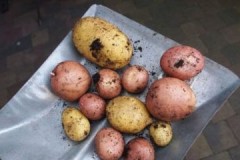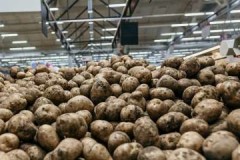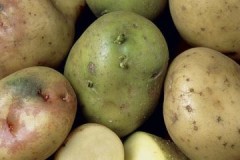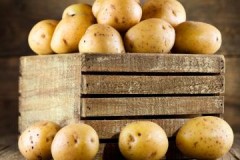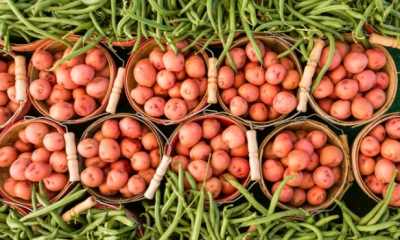 Potatoes contain a large amount of vitamins and minerals that have a beneficial effect on the human body. To preserve the nutrients in a vegetable, it is important to store it properly.
Potatoes contain a large amount of vitamins and minerals that have a beneficial effect on the human body. To preserve the nutrients in a vegetable, it is important to store it properly.
The harvested crop requires certain conditions. After all, potatoes need to be stored for a long time and at the same time you want them to remain tasty and fresh for a long time.
We will tell you further how to properly store potatoes, at what temperature and conditions.
Content
- Potato shelf life
- Conditions and requirements according to GOST
- Features of keeping root vegetables in a cellar or basement in winter
- How to preserve at home?
- Selection of containers
- Where is the best place to keep peeled tubers?
- Why does the vegetable turn green?
- Technology for storing crops on the farm
- Conclusion
Potato shelf life
The period of time during which potatoes remain edible, depends on what form the product is in at the moment, in what conditions it is stored and whether it is prepared:
- Fresh:
- at t up to +10° 3-6 months.
- at room temperature up to 14 days.
- Raw, chopped, placed in water: 1 day.
- In the refrigerator compartment:
- finished puree - up to 4 days.
- baked product - 3-4 days.
- boiled - 4 days.
- Cooked and frozen: 1 year.
- Potatoes in dry powder: 2-3 years.
You can find out how long potatoes can be stored and under what conditions. herehow long fried and stewed food can be stored, read in this article, boiled - in this, in the form of puree - in this.
Conditions and requirements according to GOST
 At what degrees, according to GOST, should potatoes be stored? According to the standards for storing vegetables optimal temperature range from +3° to +6° C.
At what degrees, according to GOST, should potatoes be stored? According to the standards for storing vegetables optimal temperature range from +3° to +6° C.
If the purpose of potatoes is further processing for food production, for example, making chips, then it is recommended to increase the temperature to +7° +10°.
In this case, in the last two weeks of storage it must be raised to +10° +14°, and sometimes to +20° C. Relative humidity requirements: from 85% to 95%. What is the storage temperature for potatoes, you can find out here.
Features of keeping root vegetables in a cellar or basement in winter
Among the many storage methods, the most optimal is to place stocks of vegetables in the basement or cellar. In order for the crop to remain fresh for a long time, a number of conditions must be met:
- Maintaining a temperature of about +3 +5° C. If it is too warm, the potatoes will begin to sprout; if it is frosty, they will freeze, which will make them unsuitable for food.
- Darkness in the room. This condition is necessary to prevent the appearance of solanine in the vegetable.
- State of rest. Metabolic processes are not suspended, the product continues to breathe and release moisture.
- Good ventilation. It is necessary to exclude high air humidity and the appearance of condensation to avoid the development of rot.
- Protection from rodents, eliminating cracks in the room.
- It is recommended to sprinkle the floor in the basement or cellar with sand. It will partially combat excess moisture.
- You should not allow the use of materials such as slate or linoleum in the cellar. Because they provoke the formation of fungus.
The rules for storing potatoes in a cellar or basement are discussed in this article.
How to preserve at home?
It is difficult to create conditions for storing potatoes in an apartment or house.
Create an optimal environment for potatoes at home, you can, subject to certain rules:
 Do not place vegetables near radiators or other heating devices.
Do not place vegetables near radiators or other heating devices.- For storage, you should choose the coolest place. But at the same time it is necessary to prevent freezing of root crops.
- Optimum humidity (80-90%) should be maintained. Since when it decreases, the potatoes lose their juiciness and become flabby. With high humidity, fungal diseases and rot develop.
- Do not place boxes with vegetables close to surfaces where condensation forms.
- Adequate ventilation must be provided. Ventilate the room periodically.
- Cover the tubers with sawdust; they will absorb unnecessary moisture.
- Do not store potatoes with other vegetables (exception: beets).
- Close the drawers from exposure to light.
Harmoniously and correctly selected humidity and temperature are the key to long-term storage of potatoes at home. If the parameters are met, root vegetables can remain fresh for up to six months. Read about storing potatoes in the refrigerator Here, on the balcony - here.
Selection of containers
A properly selected container will allow root vegetables to remain fresh longer. Its most suitable types:
- canvas bag allows the tubers to “breathe” and does not interfere with air circulation;
- wicker basket well ventilated, helps maintain optimal humidity;
- wooden box the most practical option is made from boards with gaps left; such a container retains light well, but at the same time allows air to pass through;
- plastic container must have cracks and holes so that the potatoes “breathe”;
- synthetic fiber mesh is able to provide sufficient air circulation, is spacious, practical and inexpensive.
Can I use plastic? Yes, if the vegetables need to be placed in the refrigerator for a short period of time. An overview of potato storage boxes is presented in this article, for keeping vegetables on the balcony - in this.
Where is the best place to keep peeled tubers?
 Peeled root vegetables tend to quickly deteriorate, darken and lose their beneficial qualities.
Peeled root vegetables tend to quickly deteriorate, darken and lose their beneficial qualities.
The shelf life of such potatoes is as follows:
- the product will last no more than 3-4 hours in cold water;
- in the refrigerator compartment - 12 hours.
When potatoes are left in the air for a long time, they quickly darken, begin to become covered with a dense crust, and shrink. You can eat this product. But it has an unpresentable appearance and gradually loses its original taste. Details - in this article.
Why does the vegetable turn green?
Root crops actively begin to turn green with prolonged exposure to sunlight and light.. During this, a biological process occurs - photosynthesis. A chemical reaction occurs, as a result of which a toxic substance is formed inside the potato - corned beef.
In this regard, vegetables on which green spots have appeared should not be eaten. Types of heat treatment such as boiling, stewing, and frying are not capable of destroying solanine. In addition, the product will have an unpleasant, bitter taste with an astringent effect.
Read more here.
Technology for storing crops on the farm
Potato stocks when stored in agricultural premises and warehouses tend to emit a small amount of moisture and heat, unlike other types of products.
To identify parameters for storage, always pay attention to factors such as:
- degree of ripening;
- ripening time;
- variety;
- appointment.
In agriculture, ware potatoes are stored following a certain technology in each period. They are divided into:
-
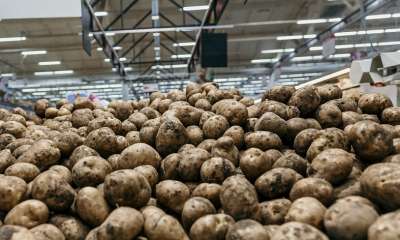 “Medicinal” (post-harvest). Lasts from several days to 3 weeks. If the root crops are fully ripe and have minor damage caused during harvesting, the period will be minimal.
“Medicinal” (post-harvest). Lasts from several days to 3 weeks. If the root crops are fully ripe and have minor damage caused during harvesting, the period will be minimal.Unripe tubers with thin skin and significant mechanical damage will have to go through this period to the maximum.
During the “treatment”, optimal conditions are created for the ripening of potatoes and their restoration after damage. During this period, the temperature is maintained at +15 +20° C and relative humidity 85-95%. At the end of the period, t must be reduced to +10°C. If you do not adhere to this technology, carbon dioxide begins to be actively released.
- “Forced Rest” (main). During the transition from the “treatment” period to the main one, t-ru must be gradually reduced by 0.5-1 degrees. The relative humidity should be 90-95%. For the purpose of prevention, in order to avoid the development of late blight, t-py is reduced to +1°C.
- “Spring” (beginning of germination). In order to prevent the germination of root crops, the indoor storage temperature is reduced by 1-3 degrees relative to the main period. Tubers have a high heat capacity, due to which they tend to accumulate cold reserves. This allows you to prevent an increase in temperature in product stacks.
Read more Here.
Conclusion
Potato fruits grow in the ground, as a result of which dug up tubers are well stored in conditions that are closest to natural ones - it should be dark and cold. The most suitable temperature for storage is from +7° to +12° C.
A basement or cellar is the most suitable storage space. If it is not possible to place potatoes in them, then you should find the coolest and darkest possible place in your home for root vegetables.
